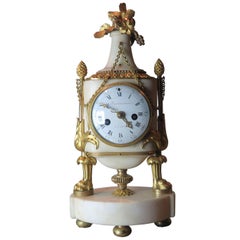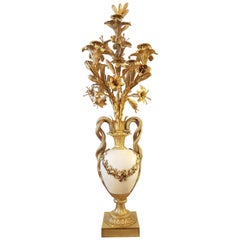Louis Xvi Giltbronze
Vintage 1930s French Louis XVI Fireplaces and Mantels
Bronze
Recent Sales
Antique 18th Century French Louis XVI Mantel Clocks
Marble, Bronze
Antique 1780s French Louis XVI Candelabras
Marble, Bronze
Antique Mid-19th Century European Louis XVI Table Clocks and Desk Clocks
Enamel, Bronze
Antique 1780s French Louis XVI Figurative Sculptures
Bronze
Vintage 1910s French Louis XVI Chandeliers and Pendants
Bronze
Antique 19th Century French Louis XVI Chandeliers and Pendants
Crystal, Bronze
Antique 1780s French Louis XVI Urns
Marble, Bronze
Early 20th Century French Candle Holders
Crystal
Antique 1890s French Louis XVI Chandeliers and Pendants
Bronze
A Close Look at Louis-xvi Furniture
Reflecting the final era of royal opulence before the upheaval of the French Revolution, antique Louis XVI furniture features more angular shapes than the Rococo curves of the Louis XV style, harkening back to the imposing grandeur of Louis XIV.
Dating between 1750 and 1800, an era that overlapped with the last king of France whose reign was cut short by the guillotine, Louis XVI furniture, known as the goût grec, is emblematic of the neoclassical revision that French furniture underwent during the second half of the 18th century.
Authentic Louis XVI furniture characteristics include clean lines and carved details such as scrolls and acanthus flourishes that were inspired by ancient Greece and Rome. This was informed by a burgeoning interest in antiquity in the 18th century, owing to new archaeological excavations at sites including Pompeii and Herculaneum. It largely eclipsed the more East Asian–influenced ornamentation of Louis XV for something more geometric and symmetrical.
The Louis XVI style was defined by what was being created for the palatial rooms at Versailles and Fontainebleau, particularly for the queen, with cabinetmaker Jean-Henri Riesener being a favorite of Marie-Antoinette’s for his luxurious pieces accented with gilded bronze and marquetry. Furniture maker Jean-Baptiste-Claude Sené was also a major designer of the period, with his pieces for the royal residences adorned with giltwood and neoclassical touches like tapered columns for chair legs and laurel leaf carvings. Cabinetmaker Adam Weisweiler occasionally incorporated into his furniture porcelain panels produced by Sèvres, a popular manufacturer of European ceramics that served the crown with serveware, vases and other decorative objects.
Find a collection of antique Louis XVI seating, tables, cabinets and other furniture on 1stDibs.
- 1stDibs ExpertNovember 4, 2024To identify Louis XVI chairs, first familiarize yourself with the characteristics of the design style by looking at images found on trusted online resources. Often, Louis XVI chairs rest on straight, column-like legs, and their frames show off intricate carvings such as scrollwork rosettes, fluting and ribbon twists. Typically, chairs from the era have recessed arms connected to the front of the seat via an elegant curve. Artisans of the period typically constructed chairs in mahogany, walnut or oak wood. If your chair has these features, it will likely be an original Louis XVI piece or a reproduction based on one. To tell antiques apart from contemporary chairs, consider their overall condition.
Due to their age, originals will likely show some signs of wear, and you may be able to spot visible tool marks or slight irregularities in the carvings due to their handcrafted origins. A chair that looks unused and is completely uniform with no tool marks is less likely to be an original. When in doubt, check with a certified appraiser or experienced antique dealer.
On 1stDibs, find a selection of Louis XVI chairs.
Read More
What Is Ormolu, and Why Are We Talking about It?
This golden material glamorized neoclassical furnishings and transformed upper-crust sitting rooms from France to Philadelphia in the 18th and early 19th centuries.
How to Spot Louis XIV, Louis XV and Louis XVI Chairs
A field guide for anyone who wants to brush up on their knowledge of French antiques


